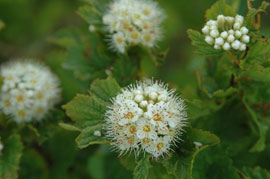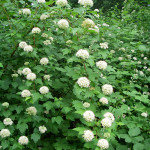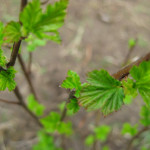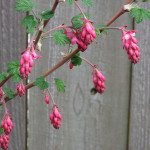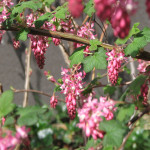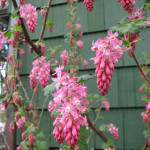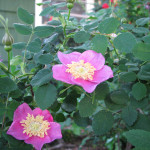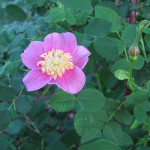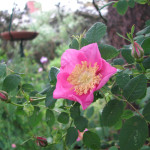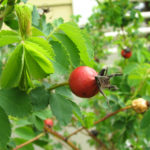Physocarpus capitatus
Pacific ninebark (Physocarpus capitatus) is a dense deciduous shrub growing up to 12 feet tall. The name refers to the unusual bark, which naturally peels off in many colorful layers.
The shrub has maple-like lobed leaves and attractive clusters of small white flowers in May and June. The unique fruit is a glossy red pod which turns dry and brown, and then splits open to release seeds.
The twigs, berries, buds, and leaves are all browsed by wildlife. Pacific ninebark is very important for pollinators, especially solitary bees who lay their eggs and take shelter for the winter in the hollow stems. Pacific ninebark is also a food source for the young of spring azure butterflies, and many birds use it for nesting.
It is often found in wetlands, but also forms thickets along rivers and in moist forest habitats. It can also tolerate some drought. Create a dense deciduous screen by growing it in combination with oceanspray and Douglas spirea. Best in full sun to part shade.
- Light Requirements: Part Shade
- Water Requirements: Moist, Seasonally Wet
- Ease of Growing: Easy to grow
- Growth Rate: Fast
- Spreads: Yes
- Wildlife Support: Pollinators, Pest-eating Insects, Birds or Mammals
- Fire-resistant: Yes
- Edible: No
- Mature Height: 8-12ft
- Mature Width:4-7ft
Red Flowering Currant
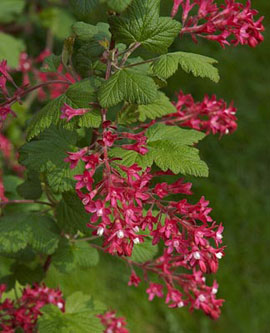
Ribes sanguineum var. sanguineum
Red flowering currant (Ribes sanguineum) is an upright, multi-stemmed deciduous shrub that can get 6-10 feet tall, and is considered one of our prettiest native shrubs. Its bright pink, dangling flower clusters in late February and March are welcome signs of spring!
The bark is dark brownish-grey with pale brown lenticels. The palmate leaves have five lobes, and young leaves and flowers have a scent variously described as spicy or resinous. The fruits form as clusters of dark purple berries which contrast beautifully with the rosy gold fall foliage.
Keep a pair of binoculars handy if you plant this lovely shrub, because red flowering currant is a favorite of hummingbirds and other wildlife all year long. The flowers are important early spring nectar sources for rufous and Anna’s hummingbirds, spring azure and mourning cloak butterflies, and many native bees. Many birds eat the berries in the fall and winter, including towhees, thrushes, cedar waxwings, and sparrows. This charming plant also hosts the eggs of zephyr butterflies, and provides shelter for songbirds.
Red flowering currant can tolerate shade, but grows best (and blooms the most) in sunny locations with well drained soils.
- Light Requirements: Full Sun, Part Shade
- Water Requirements: Dry, Moist
- Ease of Growing: Easy to grow
- Growth Rate: Fast
- Spreads:
- Wildlife Support: Pollinators, Hummingbirds, Pest-eating Insects, Birds or Mammals
- Fire-resistant: Yes
- Edible: Yes
- Mature Height: 4-10ft
- Mature Width:3-10ft
Nootka Rose
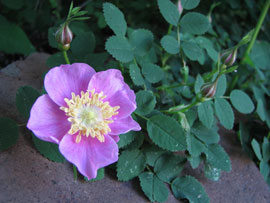
Rosa nutkana var. nutkana
The Nootka rose is an attractive shrub growing up to 9′ high. The straight, erect stems are usually green, but occasionally may be reddish. The prickles are larger and thicker than those of the other native rose species.
The leaves are alternate on the stems and pinnately compound with 5-7 leaflets, dark green above, paler and slightly hairy below. The leaflets are elliptic or ovate in shape with serrate margins, and range from 1-7 cm long and 0.7-4.5 cm wide.
The sweet-scented, pink flowers are usually solitary, occasionally growing in groups of 2 or 3. They are large and showy, ranging from 5-8 cm across. Individual petals are 2.5-4 cm long, and 5 petals are the norm for the flowers. The rose hips are spherical, orange-red and large, ranging from 1-2 cm wide.
Uses
Wild rose is spindly and tends to form loose thickets, which in large spaces makes it useful as a hedgerow or as a wildlife-friendly ornamental. The leaves and fruits are important food sources for herbivores and upland game birds, and rose thickets provide excellent nesting and escape habitat for songbirds. The plant also has many traditional uses in Native American culture. Rose hips can be made into jam, tea, and used as flavoring, and the leaves have a variety of medicinal uses. Dried flower petals are used for scents and potpourri.
Habitat
Nootka rose may be found in open upland woods or in open shrub wetlands. In areas where both Rosa nutkana and Rosa woodsii occur, the former may be found at higher elevations and often in woods.
- Light Requirements: Full Sun, Part Shade
- Water Requirements: Dry, Moist, Seasonally Wet
- Ease of Growing: Easy to grow
- Growth Rate: Moderate
- Spreads: Yes
- Wildlife Support: Pollinators, Pest-eating Insects, Birds or Mammals
- Fire-resistant: Yes
- Edible: Yes
- Mature Height: 6-10ft
- Mature Width:3-4ft

